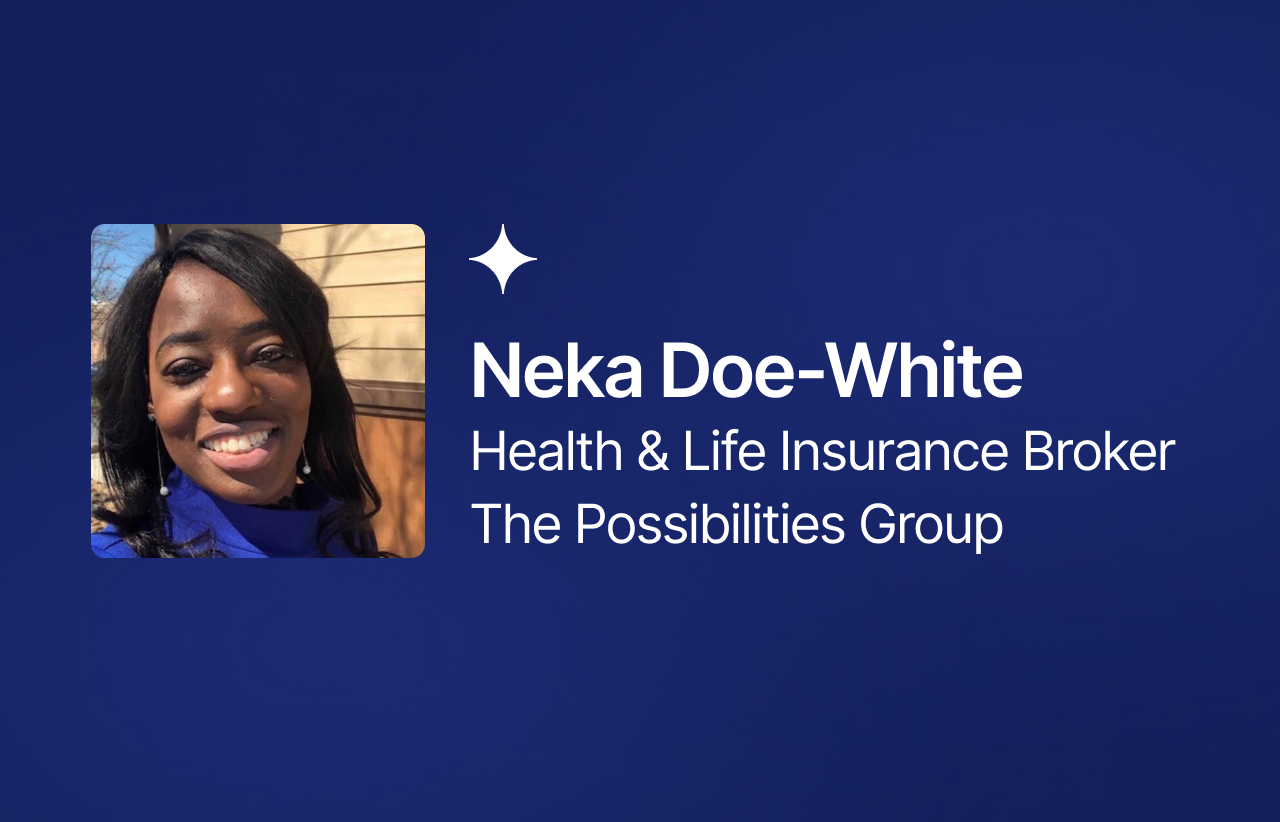It’s Monday morning and you’ve got the entire week ahead of you. Now you need to fill your calendar with back-to-back appointments with prospects who you can educate about Medicare and hopefully enroll into a plan. But unfortunately those appointments won’t just magically appear. As any seasoned Medicare agent will tell you, finding prospects is the lifeblood of their business.
When you’re just starting out, we recommend focusing on 1 or 2 channels and creating a repeatable process. You can of course go first to your friends and family, but those opportunities will quickly run out so it’s important to plan ahead so you know how to stay busy. In this guide, we’ll cover all of the ways that successful Medicare agents generate leads, opportunities, and ultimately, clients. In Part 1, we’ll review Paid lead channels and in Part 2, we’ll move to Organic lead channels.
Paid leads are the easiest - and most costly - way to generate leads because you simply pay for them. There are many types of paid leads, such as data leads, call-verified leads, inbound calls, and warm transfers that come from various sources, such as mailers, Facebook, Google, and email. You can also try the “do-it-yourself” approach, such as using Facebook yourself to generate leads, or work via vendors who do all the work for you and charge a per-lead amount. These leads vary substantially in terms of quality, cost, and reliability. For example, some data leads can cost as little as $5 but are sold to multiple agents, while call leads can exceed $80 for a 60 second phone call. What’s important is you find a lead source that you can rely on regularly with a good return on investment and that fits your personal financial situation, past experience, and work style.
Types of paid leads
The “type” of paid lead describes how the lead gets to you. For example, you might receive a name and number in an email, a name and number in a CSV file, or an inbound phone call. There’s nuance to all of the leads that impacts the best way to work them, so read carefully! Broadly speaking, we’ll split the paid leads into data leads and call leads.
Data leads
A “data lead” is exactly what it sounds like; you’ll get written data with the prospect’s information on it and you’re responsible for all the follow up. Because you have to do the work to get the prospect on the phone, these leads are typically cheaper than call leads. They also tend to be more predictable in terms of when you receive them, and easier to segment by age and location.
Format
You’ll receive the name, date of birth, contact information, and other basic information associated with a prospect who gave consent to be contacted about Medicare. It is critical that the vendor you work with can show that the prospect has consented to be contacted.
Cost
$10 - $30 per lead depending on how the lead was generated. In some cases the data lead can be below $10, especially if it is old or has been shared with other agents already. We recommend never purchasing these so-called “shared leads”. We also offer higher-quality call-verified leads, where the prospect has been told that you'll be calling them within the next few days at an approximate time (morning, afternoon, evening).
How to work with them
These leads require you (or your assistant) to dial them shortly after receiving them, and several times over the subsequent days. The longer you hold off on contacting them, the lower your conversation rate.
Our main takeaways
- You should call leads at least once every 24 hours for 3 days until you are able to contact the prospect. If you’re able to, try calling at various times of the day. The general rule of thumb is to attempt 10 times over a 2 week period before marking them as closed.
- For leads that don’t pick up, you should leave a voicemail introducing yourself and your unique value prop.
- In addition to calling, you should send text and email follow-ups when possible over the 3 day period after you get the opportunity.
- It’s okay to be persistent! There is a fine line between persistence and pushiness. You should feel proud of the value you can provide your prospect as a local Medicare expert -- if you don’t reach the prospect, someone else who cares less about the consumer might.
What to expect
Don’t get discouraged if you struggle to get in touch with prospects immediately! Only a small percent need to convert for you to have a good return on investment. The general rule is that you should at least cover the cost with the first year of revenue, so that you’re earning a return from the renewal years. Here’s how the math works:
- Buy 50 leads for $1,000. The price per lead is $20.
- You can convert 20% of leads to meetings. You will have 10 meetings.
- You can convert 30% of those meetings into clients. You will have approximately 3 clients. Your total conversion rate is 3 / 50, or 6%.
- Depending on the type of client (e.g. a client who is turning 65 will generate 2x more than a replacement policy), that will net approximately $1k.
- You have broken even in your first year, and should look forward to years of renewal revenue!
Vendors we work with
We work with many vendors and which one you choose will depend on the types of clients you work with (Medicare Advantage vs. Medicare Supplement), your markets, and the sources you prefer (mail, facebook, etc.). If you are looking for mail-based leads, we recommend:
- Lead Concepts: pay $510 per 1,000 mailers (expect no more than a 2% response rate)
- RGI: pay $20 - 25 per lead generated
You can find a comprehensive list of vendors here
Call leads
Inbound calls require the least work from you because the prospect comes straight to you on the phone! These call leads can be used to generate many enrollments very quickly, but they’re expensive and require you to commit to being available for specific time windows. You’ll get charged for missed calls, so make sure that once you turn on the call leads, you will be available 100% of the time. We generally recommend that you don’t move onto call leads until you can demonstrate a consistent conversion rate from your conversations with Medicare prospects.
Format
The format varies slightly by the vendor, but you’ll generally input your available hours, state preferences, and - in limited circumstances - any characteristics about the leads (e.g. you might be able to filter by age. Careful not to overdo this! It can get more expensive with the more filters you add). No outbound calling is required. You’ll receive calls to your number between the time frames you specified. You can add a maximum budget cap so that you don’t spend more than you want to.
Cost
$55 - 80 per lead, depending on the source
How to work with them
Most vendors will charge you for missing a call, while others will only penalize you by increasing the price of future calls. For this reason, we recommend setting aside concentrated periods during which you can receive the calls.
- Within <10 seconds of receiving a call, you'll be able to see the lead's key information in the vendor’s portal. You’ll have between 60 - 90 seconds of “buffer” time during which you can further qualify the prospect. If you hang up within that time period, you won’t be charged.
- Use that buffer time wisely! Screen out leads who are clearly in the wrong place, such as those looking for Medicaid support or general social security sign up.
What to expect
The calls you receive won’t be like the start of your typical Medicare appointment. Prospects on the phone undergo minimal screening so quality varies widely; sometimes you'll receive calls about home health aides, Medicaid, or Social Security, and prospects might be rushing to receive an answer immediately or confused how they got to you in the first place. The prospects get to you in many different ways, and the vendors don’t share (or even know!) the specific route they took. What’s important is that you screen the prospects quickly so you aren’t charged repeatedly for unqualified leads.
In addition, many prospects might not be ready to enroll yet, and are calling months in advance of when they’re eligible. That’s ok though. Be helpful, build a relationship, and nurture that prospect over the next few months.
Vendors we work with
There are two types of vendors that you can use. Some are simply outsourced call assistants – you can provide them with data leads and they can call them to set appointments (an example is Lead Heroes - priced on a per-campaign basis, around $960 for 2 weeks. Others, such as Datalot and Quantum Digital Media, charge per lead
How the leads are generated
While data leads and call leads might get to you in a different format, they are often relying on similar marketing channels. For example, one vendor might run a Facebook ad requesting that the prospect add their number and email to request a call back. That will generate a data lead. Another vendor might run a Facebook campaign requesting the prospect to call a number directly. That will generate a call lead. Here are a few of the most common places that leads come from:
- Web forms: a consumer inputs their information into an online form
- Google: a consumer clicks on a Google search result, which brings them to an online form or automatically starts a call.
- Facebook: a consumer submits their information directly into a Facebook form, or they click an add which brings them to another online form.
- Mailers: a consumer tears off a part of a mail advertisement and submits a request for additional information, or they call the number on the Mailer ad.
- Out-of-home advertising, such as billboards: a consumer sees an advertisement on the billboard, navigates to the website, and submits and online form, or simply calls the number on the billboard.
- And many more, such as TV, radio, magazine, and email newsletter advertisements.
Do-it-yourself vs. paying a vendor
As you can imagine, generating leads yourself is quite a lot of work. Say you want to create a Facebook campaign. You’ll have to:
- Create several types of ads (you can see many ad samples here)
- Write the copy alongside the ads
- Potentially create a landing page for the prospect to visit after clicking the ad
- Track ad performance and actively manage the budget
- … and actually follow up on all the leads you’re generating!
And that’s only for 1 channel! If you want to expand to Google or out-of-home advertising, you’ll have to do it all over again. Plus, you’ll have limited budget to work with so don’t get any of the benefits of operating at scale like some of the large marketing vendors.
Still, you might have a niche insight that will convince you to run all of the ads yourself. If you go this route, please reach out to us and we’d love to help.
Getting started with Paid Leads
If you made it to this point, you should have a good understanding of the types of data leads and some ideas about how you want to get started. We recommend first speaking with your Strategic Growth Manager who can help you set a budget, select a vendor, and create a schedule so you can track your performance. We’re looking forward to growing with you!

.jpeg)









.png)






.png)




.png)




.png)
.png)
.jpeg)





.png)


.png)
.png)



.png)
.jpeg)


.png)














.png)

.png)



.png)

.png)


